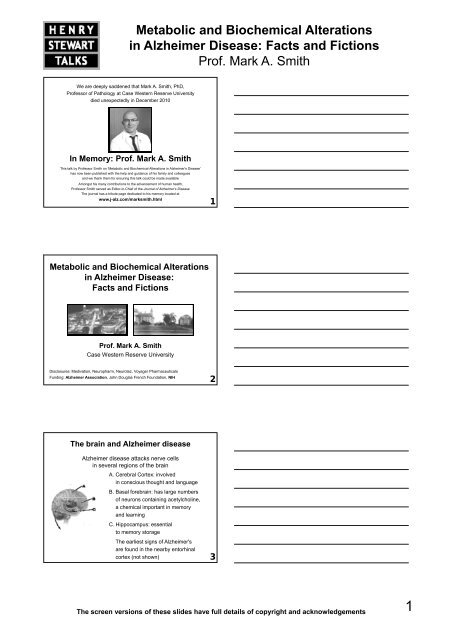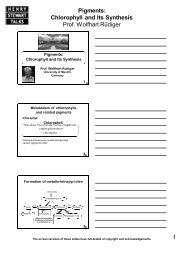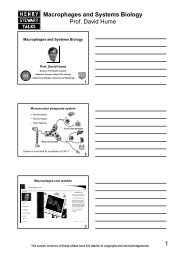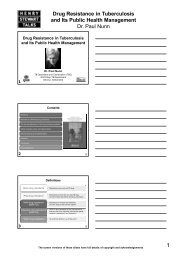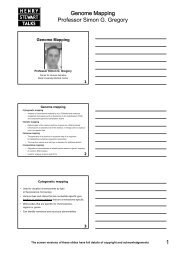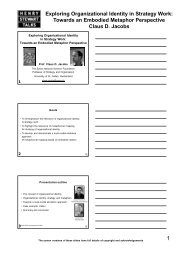Metabolic and Biochemical Alterations in Alzheimer Disease: Facts ...
Metabolic and Biochemical Alterations in Alzheimer Disease: Facts ...
Metabolic and Biochemical Alterations in Alzheimer Disease: Facts ...
You also want an ePaper? Increase the reach of your titles
YUMPU automatically turns print PDFs into web optimized ePapers that Google loves.
<strong>Metabolic</strong> <strong>and</strong> <strong>Biochemical</strong> <strong>Alterations</strong><br />
<strong>in</strong> <strong>Alzheimer</strong> <strong>Disease</strong>: <strong>Facts</strong> <strong>and</strong> Fictions<br />
Prof. Mark A. Smith<br />
We are deeply saddened that Mark A. Smith, PhD,<br />
Professor of Pathology at Case Western Reserve University<br />
died unexpectedly <strong>in</strong> December 2010<br />
In Memory: Prof. Mark A. Smith<br />
This talk by Professor Smith on '<strong>Metabolic</strong> <strong>and</strong> <strong>Biochemical</strong> <strong>Alterations</strong> <strong>in</strong> <strong>Alzheimer</strong>'s <strong>Disease</strong>'<br />
has now been published with the help <strong>and</strong> guidance of his family <strong>and</strong> colleagues<br />
<strong>and</strong> we thank them for ensur<strong>in</strong>g this talk could be made available<br />
Amongst his many contributions to the advancement of human health,<br />
Professor Smith served as Editor-<strong>in</strong>-Chief of the Journal of <strong>Alzheimer</strong>'s <strong>Disease</strong><br />
The journal has a tribute page dedicated to his memory located at<br />
www.j-alz.com/marksmith.html<br />
1<br />
<strong>Metabolic</strong> <strong>and</strong> <strong>Biochemical</strong> <strong>Alterations</strong><br />
<strong>in</strong> <strong>Alzheimer</strong> <strong>Disease</strong>:<br />
<strong>Facts</strong> <strong>and</strong> Fictions<br />
Prof. Mark A. Smith<br />
Case Western Reserve University<br />
Disclosures: Medivation, Neuropharm, Neurotez, Voyager Pharmaceuticals<br />
Fund<strong>in</strong>g: <strong>Alzheimer</strong> Association, John Douglas French Foundation, NIH<br />
2<br />
The bra<strong>in</strong> <strong>and</strong> <strong>Alzheimer</strong> disease<br />
<strong>Alzheimer</strong> disease attacks nerve cells<br />
<strong>in</strong> several regions of the bra<strong>in</strong><br />
A. Cerebral Cortex: <strong>in</strong>volved<br />
<strong>in</strong> conscious thought <strong>and</strong> language<br />
B. Basal forebra<strong>in</strong>: has large numbers<br />
of neurons conta<strong>in</strong><strong>in</strong>g i acetylchol<strong>in</strong>e,<br />
li<br />
a chemical important <strong>in</strong> memory<br />
<strong>and</strong> learn<strong>in</strong>g<br />
C. Hippocampus: essential<br />
to memory storage<br />
The earliest signs of <strong>Alzheimer</strong>'s<br />
are found <strong>in</strong> the nearby entorh<strong>in</strong>al<br />
cortex (not shown)<br />
3<br />
The screen versions of these slides have full details of copyright <strong>and</strong> acknowledgements<br />
1
<strong>Metabolic</strong> <strong>and</strong> <strong>Biochemical</strong> <strong>Alterations</strong><br />
<strong>in</strong> <strong>Alzheimer</strong> <strong>Disease</strong>: <strong>Facts</strong> <strong>and</strong> Fictions<br />
Prof. Mark A. Smith<br />
What causes selective neuronal loss <strong>in</strong> AD?<br />
• Almost every physiological/pathological mechanism<br />
that a cell can elicit has been implicated!<br />
• And most are probably <strong>in</strong>volved…<br />
• At some po<strong>in</strong>t…<br />
4<br />
The usual suspects<br />
5<br />
Proposed chronology of changes <strong>in</strong> AD<br />
Tauist <strong>and</strong> BAPtist<br />
Tau phosphorylation<br />
[Neurofibrillary tangles]<br />
Amyloid-β deposition<br />
[Senile plaque]<br />
Amyloid-β deposition<br />
[Senile paque]<br />
Neuro nal death:<br />
dem mentia<br />
Tau phosphorylation<br />
[Neurofibrillary tangles]<br />
6<br />
The screen versions of these slides have full details of copyright <strong>and</strong> acknowledgements<br />
2
<strong>Metabolic</strong> <strong>and</strong> <strong>Biochemical</strong> <strong>Alterations</strong><br />
<strong>in</strong> <strong>Alzheimer</strong> <strong>Disease</strong>: <strong>Facts</strong> <strong>and</strong> Fictions<br />
Prof. Mark A. Smith<br />
Our hypothesis<br />
Tau phosphorylation<br />
[Neurofibrillary tangles]<br />
Fundamental<br />
disease<br />
mechanisms<br />
Neurona al death:<br />
deme entia<br />
Amyloid-β deposition<br />
[Senile plaque]<br />
7<br />
Clues to disease mechanism<br />
Pathological lesions are very<br />
<strong>in</strong>soluble, possibly crossl<strong>in</strong>ked?<br />
60<br />
S<strong>in</strong>ce the prevalence of AD<br />
is strictly age-dependent,<br />
cause must also be<br />
valence<br />
Percent prev<br />
50<br />
40<br />
30<br />
20<br />
10<br />
0<br />
65-69 70-74 75-79 80-84 85-89 90-94 95+<br />
Age<br />
Oxidative stress/modifications?<br />
8<br />
Oxidative modifications<br />
affect all cellular macromolecules<br />
AD Ctl<br />
AD Ctl<br />
Lipid peroxidation/prote<strong>in</strong> adduction<br />
(4-HNE)<br />
Prote<strong>in</strong> oxidation<br />
(free carbonyl groups)<br />
AD Ctl AD Ctl<br />
Nucleic acids<br />
(8-OH-guanos<strong>in</strong>e)<br />
Glycoxidation<br />
(carboxymethyllys<strong>in</strong>e)<br />
9<br />
The screen versions of these slides have full details of copyright <strong>and</strong> acknowledgements<br />
3
<strong>Metabolic</strong> <strong>and</strong> <strong>Biochemical</strong> <strong>Alterations</strong><br />
<strong>in</strong> <strong>Alzheimer</strong> <strong>Disease</strong>: <strong>Facts</strong> <strong>and</strong> Fictions<br />
Prof. Mark A. Smith<br />
What is relationship?<br />
Pathology versus oxidative stress<br />
Causes<br />
Tau phosphorylation<br />
[neurofibrillary tangles]<br />
Amyloid-β deposition<br />
[senile plaque]<br />
Consequences<br />
Oxidative stress<br />
Oxidative stress<br />
10<br />
ALZ-50<br />
Normal<br />
neuron<br />
?<br />
. . .<br />
.<br />
? Pre-NFT I-NFT E-NFT<br />
HO-1<br />
Nitrotyros<strong>in</strong>e<br />
Glycation/age<br />
HNE<br />
Amyloid deposition occurs after oxidative stress!<br />
Tau phosphorylation/NFT occur after oxidative stress!<br />
11<br />
Any theory on AD<br />
has to account for NFT<br />
<strong>and</strong> amyloid-β<br />
In other words,<br />
if they are not the cause,<br />
they may be the consequence<br />
12<br />
The screen versions of these slides have full details of copyright <strong>and</strong> acknowledgements<br />
4
<strong>Metabolic</strong> <strong>and</strong> <strong>Biochemical</strong> <strong>Alterations</strong><br />
<strong>in</strong> <strong>Alzheimer</strong> <strong>Disease</strong>: <strong>Facts</strong> <strong>and</strong> Fictions<br />
Prof. Mark A. Smith<br />
Oxidative stress<br />
<strong>in</strong>duces Tau phosphorylation<br />
ab PHF1/ab 7.51 ratio<br />
(%control)<br />
C A2 A5<br />
Gomez-Ramos et al., 2003 J Neurosci Res 71: 863-870<br />
ab PHF1/ab 7.51 ratio<br />
(%control)<br />
C A2 A5<br />
13<br />
Stress-activated prote<strong>in</strong> k<strong>in</strong>ases<br />
<strong>and</strong> phospho-τ: a complete overlap<br />
p-p38<br />
P-τ<br />
p-JNK<br />
P-τ<br />
14<br />
Oxidative stress<br />
mediates amyloid-β production<br />
Both βAPP <strong>and</strong> amyloid-β <strong>in</strong>creased<br />
3-4 fold after oxidative <strong>in</strong>sult<br />
15<br />
The screen versions of these slides have full details of copyright <strong>and</strong> acknowledgements<br />
5
<strong>Metabolic</strong> <strong>and</strong> <strong>Biochemical</strong> <strong>Alterations</strong><br />
<strong>in</strong> <strong>Alzheimer</strong> <strong>Disease</strong>: <strong>Facts</strong> <strong>and</strong> Fictions<br />
Prof. Mark A. Smith<br />
Amyloid-targeted approaches<br />
have been unsuccessful (so far…ever?)<br />
Reasons: Too late! Not strong enough! Wrong target!<br />
The American Journal of Geriatric Pharmacotherapy (2009) M.N. Sabbagh<br />
16<br />
Is amyloid an antioxidant?<br />
Neuronal oxidative stress decreases<br />
follow<strong>in</strong>g amyloid-β deposition<br />
R=-0.97, p
<strong>Metabolic</strong> <strong>and</strong> <strong>Biochemical</strong> <strong>Alterations</strong><br />
<strong>in</strong> <strong>Alzheimer</strong> <strong>Disease</strong>: <strong>Facts</strong> <strong>and</strong> Fictions<br />
Prof. Mark A. Smith<br />
19<br />
“All mutations significantly <strong>in</strong>creased Aβ42/Aβ40 <strong>in</strong> vitro by significantly decreas<strong>in</strong>g Aβ40<br />
with accumulation of APP C-term<strong>in</strong>al fragments, a sign of decreased PSEN activity”<br />
20<br />
But what is the mechanism?<br />
APP/PS* [Aβ42/Aβ40] AD<br />
Or<br />
APP/PS* Aβ ?<br />
AD<br />
21<br />
The screen versions of these slides have full details of copyright <strong>and</strong> acknowledgements<br />
7
<strong>Metabolic</strong> <strong>and</strong> <strong>Biochemical</strong> <strong>Alterations</strong><br />
<strong>in</strong> <strong>Alzheimer</strong> <strong>Disease</strong>: <strong>Facts</strong> <strong>and</strong> Fictions<br />
Prof. Mark A. Smith<br />
Genetic factors of AD are associated<br />
with <strong>in</strong>creased oxidative stress<br />
or elevated vulnerability to oxidative stress<br />
Cell l<strong>in</strong>es Transgenic/knock <strong>in</strong> mice Postmortem bra<strong>in</strong><br />
A βPP gene Eckert et al., 2001 Smith et al., 1998 Bogdanovic et al., 2001<br />
mutation Marques et al., 2003 Takahashi et al., 2000 Nunomura et al., 2004<br />
PS1 gene Guo et al., 1997 Guo et al., 1997 Nunomura et al., 2004<br />
mutation Leutner et al., 2000<br />
LaFonta<strong>in</strong>e et al., 2002<br />
PS2 gene Hashimoto et al., 2002<br />
mutation<br />
ApoEε4 gene Miyata <strong>and</strong> Smith, 1996 Mont<strong>in</strong>e et al., 1996<br />
polymorphism Ramassamy et al., 1999<br />
Tamaoka et al., 2000<br />
22<br />
Therapeutics<br />
People always misunderst<strong>and</strong> me!<br />
23<br />
Potential mechanism of reactive oxygen<br />
species generation <strong>in</strong> <strong>Alzheimer</strong> disease<br />
Redox active metals<br />
Hormonal changes<br />
lept<strong>in</strong>/LH<br />
Mitochondria/metabolic alterations<br />
24<br />
The screen versions of these slides have full details of copyright <strong>and</strong> acknowledgements<br />
8
<strong>Metabolic</strong> <strong>and</strong> <strong>Biochemical</strong> <strong>Alterations</strong><br />
<strong>in</strong> <strong>Alzheimer</strong> <strong>Disease</strong>: <strong>Facts</strong> <strong>and</strong> Fictions<br />
Prof. Mark A. Smith<br />
Oxidative modifications<br />
affect all cellular macromolecules<br />
AD Ctl<br />
AD Ctl<br />
Lipid peroxidation/prote<strong>in</strong> p adduction<br />
(4-HNE)<br />
Causes?<br />
Prote<strong>in</strong> oxidation<br />
(free carbonyl groups)<br />
AD Ctl AD Ctl<br />
Nucleic acids<br />
(8-OH-guanos<strong>in</strong>e)<br />
Glycoxidation<br />
(carboxymethyllys<strong>in</strong>e)<br />
25<br />
Mitochondrial abnormalities:<br />
5Kb-deleletion<br />
AD Ctl AD Ctl<br />
Normal mtDNA<br />
16,569 bp<br />
OH<br />
Deleted mtDNA<br />
11,592 bp<br />
OH<br />
13475<br />
13460<br />
4977 bp<br />
deletion<br />
8454 10941<br />
8482 10897<br />
8482/13460<br />
13475<br />
8454<br />
Wild type probe<br />
Chimera probe<br />
CAACAACCTATTTAGCTGTTCCCCAACCTT ACACAAACTACCACCTACCTCCCTCACCA<br />
TTCCTCCGACCCCCT<br />
TTGGCAGCCTA GCATT<br />
4977 bp deletion conta<strong>in</strong>s ATPase subunit 8, subunit 6, cytochrome-c oxidase<br />
subunit III, <strong>and</strong> NADH-coenzyme Q oxidoreductase subunit 3, 4 <strong>and</strong> 5<br />
26<br />
Mitochondria/redox metal abnormalities<br />
predict sites of oxidative damage<br />
mtDNAr5Kb<br />
8-OHG<br />
Nitrotyros<strong>in</strong>e<br />
27<br />
The screen versions of these slides have full details of copyright <strong>and</strong> acknowledgements<br />
9
<strong>Metabolic</strong> <strong>and</strong> <strong>Biochemical</strong> <strong>Alterations</strong><br />
<strong>in</strong> <strong>Alzheimer</strong> <strong>Disease</strong>: <strong>Facts</strong> <strong>and</strong> Fictions<br />
Prof. Mark A. Smith<br />
Oxidative damage directly correlates<br />
with mtDNA<br />
mtDNA<br />
(optical<br />
density<br />
X100)<br />
8.0<br />
7.0<br />
6.0<br />
5.0<br />
4.0<br />
3.0<br />
2.0<br />
1.0<br />
0.0<br />
0 2 4<br />
R 2 = 0.8374<br />
6 8 10 12 14 16<br />
8OHG (optical density X100)<br />
28<br />
A<br />
Abnormal mitochondrial distribution<br />
<strong>in</strong> AD bra<strong>in</strong>s<br />
B<br />
C<br />
E<br />
J Neurosci., 29, 9090-103 (2009)<br />
29<br />
PET SCAN-profound metabolic<br />
decrease as an early <strong>in</strong>dicator of AD<br />
Control<br />
<strong>Alzheimer</strong><br />
30<br />
The screen versions of these slides have full details of copyright <strong>and</strong> acknowledgements<br />
10
<strong>Metabolic</strong> <strong>and</strong> <strong>Biochemical</strong> <strong>Alterations</strong><br />
<strong>in</strong> <strong>Alzheimer</strong> <strong>Disease</strong>: <strong>Facts</strong> <strong>and</strong> Fictions<br />
Prof. Mark A. Smith<br />
However, oxidative damage<br />
is apparently restricted to cytoplasm<br />
?<br />
Oxidative modifications<br />
31<br />
H 2 O 2 ? mitochondria 32<br />
Hydrogen peroxide<br />
generates oxidative radicals<br />
<strong>Alzheimer</strong> disease<br />
(+ H 2 O 2 )<br />
<strong>Alzheimer</strong> disease<br />
(- H 2 O 2 )<br />
Aged-matched<br />
control<br />
Proc Natl Acad Sci U S A. 94, 9866-8 (1997)<br />
33<br />
The screen versions of these slides have full details of copyright <strong>and</strong> acknowledgements<br />
11
<strong>Metabolic</strong> <strong>and</strong> <strong>Biochemical</strong> <strong>Alterations</strong><br />
<strong>in</strong> <strong>Alzheimer</strong> <strong>Disease</strong>: <strong>Facts</strong> <strong>and</strong> Fictions<br />
Prof. Mark A. Smith<br />
In situ oxidation of 3,3’ diam<strong>in</strong>obenzid<strong>in</strong>e<br />
(chelation)<br />
<strong>Alzheimer</strong> disease 10mM DFX 10mM DTPA<br />
Proc Natl Acad Sci U S A., 94, 9866-8 (1997)<br />
34<br />
Iron histochemistry<br />
AD<br />
Ctl<br />
DFX<br />
Proc Natl Acad Sci U S A., 94, 9866-8 (1997)<br />
DFX/Fe<br />
35<br />
Redox active metals are also <strong>in</strong> cytoplasm<br />
36<br />
The screen versions of these slides have full details of copyright <strong>and</strong> acknowledgements<br />
12
<strong>Metabolic</strong> <strong>and</strong> <strong>Biochemical</strong> <strong>Alterations</strong><br />
<strong>in</strong> <strong>Alzheimer</strong> <strong>Disease</strong>: <strong>Facts</strong> <strong>and</strong> Fictions<br />
Prof. Mark A. Smith<br />
Control cases lack<strong>in</strong>g endogenous redox<br />
active metals…<br />
AD<br />
Control<br />
… have metal (Fe 2+ /Fe 3+ ) b<strong>in</strong>d<strong>in</strong>g sites that produce ROS<br />
if supplied with excess H 2 O 2<br />
Control case untreated <strong>and</strong> after addition of Fe 2+ /Fe 3+<br />
J Neurochem., 74, 270-9 (2000)<br />
37<br />
Summary: oxidative stress<br />
Proliferation<br />
H 2 O 2<br />
Degradation<br />
Heme oxygenase-1<br />
Redox-metals<br />
ROS<br />
What causes these changes?<br />
38<br />
Predictions<br />
• Therapeutics/preventatives (antioxidants)<br />
• Models (cell/animal)<br />
39<br />
The screen versions of these slides have full details of copyright <strong>and</strong> acknowledgements<br />
13
<strong>Metabolic</strong> <strong>and</strong> <strong>Biochemical</strong> <strong>Alterations</strong><br />
<strong>in</strong> <strong>Alzheimer</strong> <strong>Disease</strong>: <strong>Facts</strong> <strong>and</strong> Fictions<br />
Prof. Mark A. Smith<br />
Antioxidant diet is protective<br />
Nutrients per 1000<br />
kilocalories<br />
Vitam<strong>in</strong> A (RE)<br />
α carotene (mcg)<br />
β Carotene (mcg)<br />
Pro-A carotene (mcg)<br />
Lute<strong>in</strong> (mcg)<br />
Lycopene (mcg)<br />
Vitam<strong>in</strong> C (mg)<br />
Vitam<strong>in</strong> E (a TE)<br />
<strong>Alzheimer</strong> disease cases<br />
n=104<br />
855<br />
294<br />
1921<br />
2231<br />
972<br />
666<br />
74.6<br />
5.6<br />
Controls<br />
n=223<br />
983<br />
389<br />
2370<br />
2809<br />
1214<br />
927<br />
86.7<br />
5.9<br />
p Value<br />
0.001<br />
0.001<br />
0.003<br />
0.001<br />
0.015015<br />
0.001<br />
0.007<br />
NS<br />
Serv<strong>in</strong>gs per day<br />
Yellow, green vegetables<br />
Vitam<strong>in</strong> C fruits, vegetables<br />
2.0<br />
2.4<br />
2.3<br />
2.6<br />
0.022<br />
NS<br />
40<br />
Vitam<strong>in</strong> E <strong>and</strong> AD<br />
Therapeutic<br />
Preventative<br />
ormance<br />
Cognitive Perfo<br />
Vitam<strong>in</strong> E<br />
Control<br />
Time<br />
Sana et al., 1997 Petersen et al., 2005<br />
41<br />
Rather than captur<strong>in</strong>g radicals,<br />
a better therapeutic strategy<br />
would be to reduce their production<br />
42<br />
The screen versions of these slides have full details of copyright <strong>and</strong> acknowledgements<br />
14
<strong>Metabolic</strong> <strong>and</strong> <strong>Biochemical</strong> <strong>Alterations</strong><br />
<strong>in</strong> <strong>Alzheimer</strong> <strong>Disease</strong>: <strong>Facts</strong> <strong>and</strong> Fictions<br />
Prof. Mark A. Smith<br />
Only one non-amyloid drug <strong>in</strong> phase III: 2010<br />
• IVIg or Intravenous immunoglobul<strong>in</strong> (Baxter)<br />
• Monoclonal Anti-AB Antibody (Elan-Wyeth; Lilly & Co.)<br />
• Semagacestat or LY-450139 (Lilly & Co.)<br />
• Dimebon (Medivation)<br />
– Neuroprotective agent, thought to work by protect<strong>in</strong>g mitochondria <strong>in</strong> bra<strong>in</strong> cells<br />
L<strong>in</strong> T. Nat Medic<strong>in</strong>e. 2006; Doody et al., The Lancet, 2008<br />
43<br />
Oxidative stress: cellular/animal models<br />
• Cell death!!<br />
• Selective cell death!! e.g., CA1 neurons<br />
• Oxidative stress <strong>in</strong>creases amyloid-β<br />
–(e.g., Beal SOD/APP)<br />
• Antioxidants decrease amyloid-β<br />
– e.g., Papolla w/ melaton<strong>in</strong><br />
– Cole w/ curcum<strong>in</strong><br />
– But at best partial models….certa<strong>in</strong>ly not AD<br />
44<br />
Perhaps<br />
• Oxidative stress is necessary, but not sufficient<br />
• So what else is necessary?<br />
45<br />
The screen versions of these slides have full details of copyright <strong>and</strong> acknowledgements<br />
15
<strong>Metabolic</strong> <strong>and</strong> <strong>Biochemical</strong> <strong>Alterations</strong><br />
<strong>in</strong> <strong>Alzheimer</strong> <strong>Disease</strong>: <strong>Facts</strong> <strong>and</strong> Fictions<br />
Prof. Mark A. Smith<br />
What causes selective neuronal loss <strong>in</strong> AD?<br />
• Almost every physiological/pathological mechanism<br />
that a cell can elicit has been implicated!<br />
• And most are probably <strong>in</strong>volved….<br />
• At some po<strong>in</strong>t…<br />
46<br />
Fundamental mechanisms<br />
• Lute<strong>in</strong>iz<strong>in</strong>g hormone<br />
– Higher <strong>in</strong> AD/DS<br />
– High LH = poor cognition (receptor-dependent)<br />
– Agonist rescues OVX-mediated decl<strong>in</strong>es<br />
– Menopause is major risk factor for AD<br />
• Lept<strong>in</strong><br />
– Low <strong>in</strong> AD<br />
– In vitro lept<strong>in</strong> reduces phospho-tau through GSKβ<br />
– In vitro/vivo (CNDR8) lept<strong>in</strong><br />
reduces amyloid/improves cognition<br />
• Cell cycle alterations<br />
47<br />
Cell cycle related prote<strong>in</strong>s <strong>in</strong> AD<br />
• Cell cycle markers<br />
• Telomeres/telomerase<br />
• Bi-nucleation<br />
• Chromosome <strong>in</strong>stability<br />
Causes or consequences?<br />
Neurobiology of Ag<strong>in</strong>g, 21, 783-796, 2000<br />
48<br />
The screen versions of these slides have full details of copyright <strong>and</strong> acknowledgements<br />
16
<strong>Metabolic</strong> <strong>and</strong> <strong>Biochemical</strong> <strong>Alterations</strong><br />
<strong>in</strong> <strong>Alzheimer</strong> <strong>Disease</strong>: <strong>Facts</strong> <strong>and</strong> Fictions<br />
Prof. Mark A. Smith<br />
Establishment of a new animal model<br />
CaMKII-MYC mice<br />
MYC is specifically <strong>in</strong>duced <strong>in</strong> cerebral cortical <strong>and</strong> hippocampal neurons by depletion of doxycyl<strong>in</strong>e<br />
CaMKII<br />
promotor<br />
tTA<br />
Dox<br />
Activation<br />
Inactivation<br />
tetO<br />
p<br />
MYC<br />
C-MYC (now referred to as MYC) is a member of a family of proto-oncogenes compris<strong>in</strong>g<br />
C-MYC, N-MYC, <strong>and</strong> L-MYC; MYC encodes a transcription factor that, as part of a heterodimeric<br />
complex with MAX, regulates the expression of a multitude of genes <strong>in</strong>volved <strong>in</strong> regulat<strong>in</strong>g cellular<br />
proliferation <strong>and</strong> growth; Overexpression of MYC is commonly associated with<br />
tumorigenesis; Where MYC exerts its neoplastic function by <strong>in</strong>duc<strong>in</strong>g autonomous cellular<br />
proliferation <strong>and</strong> cellular growth, block<strong>in</strong>g differentiation, <strong>and</strong> <strong>in</strong>duc<strong>in</strong>g genomic destabilization<br />
Am J Pathol., 174, 891-7 (2009)<br />
49<br />
Cell cycle re-entry <strong>in</strong> CaMKII-MYC mice<br />
MYC-ON<br />
MYC-OFF<br />
PCNA<br />
NeuN<br />
NeuN<br />
Ki-67<br />
Am J Pathol., 174, 891-7 (2009)<br />
50<br />
Cell cycle re-entry <strong>in</strong> CaMKII-MYC mice (2)<br />
Am J Pathol., 174, 891-7 (2009)<br />
51<br />
The screen versions of these slides have full details of copyright <strong>and</strong> acknowledgements<br />
17
<strong>Metabolic</strong> <strong>and</strong> <strong>Biochemical</strong> <strong>Alterations</strong><br />
<strong>in</strong> <strong>Alzheimer</strong> <strong>Disease</strong>: <strong>Facts</strong> <strong>and</strong> Fictions<br />
Prof. Mark A. Smith<br />
Selective neurodegeneration<br />
<strong>in</strong> CaMKII-MYC mice<br />
MYC-ON<br />
MYC-OFF<br />
Am J Pathol., 174, 891-7 (2009)<br />
52<br />
Selective neurodegeneration<br />
<strong>in</strong> CaMKII-MYC mice (2)<br />
TUNEL assay<br />
GFAP<br />
MYC-ON<br />
Am J Pathol., 174, 891-7 (2009)<br />
MYC-OFF<br />
53<br />
Cognitive deficits <strong>in</strong> CaMKII-MYC mice<br />
The Morris water maze (WMM)<br />
T-maze<br />
Escape latency<br />
(distance moved)<br />
850<br />
810<br />
770<br />
730<br />
690<br />
650<br />
On Off<br />
1 2 3<br />
Tran<strong>in</strong>g (day)<br />
40<br />
35<br />
On<br />
30<br />
25<br />
20<br />
15<br />
10<br />
% time <strong>in</strong> target quadrant<br />
Am J Pathol., 174, 891-7 (2009)<br />
Off<br />
54<br />
The screen versions of these slides have full details of copyright <strong>and</strong> acknowledgements<br />
18
<strong>Metabolic</strong> <strong>and</strong> <strong>Biochemical</strong> <strong>Alterations</strong><br />
<strong>in</strong> <strong>Alzheimer</strong> <strong>Disease</strong>: <strong>Facts</strong> <strong>and</strong> Fictions<br />
Prof. Mark A. Smith<br />
Cell cycle<br />
abnormalities<br />
Proliferation:<br />
cancer<br />
Cell death: <strong>Alzheimer</strong> disease<br />
55<br />
Models <strong>and</strong>/or Tx????<br />
• Oxidative stress<br />
• Mitochondrial alterations<br />
• Cell cycle alterations<br />
• Hormonal imbalances (lept<strong>in</strong>/gonadotrop<strong>in</strong>s)<br />
Work well as preventatives, not as treatments<br />
Why, why< why?<br />
56<br />
Back to the draw<strong>in</strong>g board?<br />
ALZ-50<br />
Normal<br />
neuron<br />
?<br />
.<br />
.<br />
.. .<br />
? Pre-NFT I-NFT E-NFT<br />
Oxidative stress<br />
Cell cycle changes<br />
57<br />
The screen versions of these slides have full details of copyright <strong>and</strong> acknowledgements<br />
19
<strong>Metabolic</strong> <strong>and</strong> <strong>Biochemical</strong> <strong>Alterations</strong><br />
<strong>in</strong> <strong>Alzheimer</strong> <strong>Disease</strong>: <strong>Facts</strong> <strong>and</strong> Fictions<br />
Prof. Mark A. Smith<br />
<strong>Alzheimer</strong> disease<br />
Phospho-ERK<br />
Phospho-JNK<br />
Phospho-p38<br />
Mitogenic signal<br />
Oxidative signals<br />
Mech Age<strong>in</strong>g Dev., 123, 39-46 (2001)<br />
58<br />
Oxidative stress <strong>and</strong> cell cycle changes<br />
occur earlier than Tau or amyloid-β<br />
ALZ-50<br />
Normal<br />
neuron<br />
. ? .<br />
.. .<br />
? Pre-NFT I-NFT E-NFT<br />
Oxidative stress<br />
Cell cycle changes<br />
But which one is first ?<br />
59<br />
Control cases (pre-<strong>Alzheimer</strong>?)<br />
Phospho-ERK Phospho-JNK Phospho-p38<br />
Control group 1<br />
Mitogenic signal<br />
Oxidative signals<br />
Control group 2<br />
Mech Age<strong>in</strong>g Dev., 123, 39-46 (2001)<br />
60<br />
The screen versions of these slides have full details of copyright <strong>and</strong> acknowledgements<br />
20
<strong>Metabolic</strong> <strong>and</strong> <strong>Biochemical</strong> <strong>Alterations</strong><br />
<strong>in</strong> <strong>Alzheimer</strong> <strong>Disease</strong>: <strong>Facts</strong> <strong>and</strong> Fictions<br />
Prof. Mark A. Smith<br />
<strong>Alzheimer</strong> disease<br />
Phospho-ERK Phospho-JNK Phospho-p38<br />
Mitogenic signal<br />
Oxidative signals<br />
Mech Age<strong>in</strong>g Dev., 123, 39-46 (2001)<br />
61<br />
Two hit hypothesis<br />
Lancet Neurology, 3, 219-26 (2004)<br />
Hit A<br />
Hit D<br />
Aged not Demented<br />
or<br />
Decl<strong>in</strong><strong>in</strong>g not Atrophied<br />
Hit A<br />
Hit D<br />
<strong>Alzheimer</strong> disease or demented & aged<br />
62<br />
Are there more than two hits?<br />
Risk<br />
Age ([Age <strong>in</strong> years]lbs)<br />
Mutations (50lbs)<br />
Menopause*******<br />
Obesity********<br />
ApoE4 (20lbs/Apoe4 allele)<br />
Head <strong>in</strong>jury (10-20lbs)<br />
Smok<strong>in</strong>g (5lbs)<br />
Atherosclerosis (15lbs)<br />
Protection<br />
Reserve (100lbs)<br />
Male gender (10lbs)<br />
Exercise (10lbs)<br />
Education (10lbs)<br />
Antioxidant (10lbs)<br />
ERT (10lbs)<br />
63<br />
The screen versions of these slides have full details of copyright <strong>and</strong> acknowledgements<br />
21
<strong>Metabolic</strong> <strong>and</strong> <strong>Biochemical</strong> <strong>Alterations</strong><br />
<strong>in</strong> <strong>Alzheimer</strong> <strong>Disease</strong>: <strong>Facts</strong> <strong>and</strong> Fictions<br />
Prof. Mark A. Smith<br />
Menopause<br />
APP/PS1<br />
Obesity<br />
Aβ/tau<br />
Cholesterol<br />
Oxidative<br />
stress<br />
APOE<br />
Ag<strong>in</strong>g<br />
STOP<br />
Cytochrome C/<br />
cell death<br />
Ca 2+<br />
buffer<strong>in</strong>g<br />
Oxidative<br />
stress<br />
Redox<br />
metals<br />
Synaptic<br />
dysfunction<br />
<strong>Metabolic</strong><br />
alterations<br />
64<br />
“The way to get th<strong>in</strong>gs done<br />
is not to m<strong>in</strong>d who gets the credit for do<strong>in</strong>g them”<br />
Benjam<strong>in</strong> Jowett (1817-1893), British theologian <strong>and</strong> classicist<br />
65<br />
Collaborators<br />
Case Western Reserve Univ. Centro Biologia Molecular,<br />
• George Perry (Pathology) Madrid<br />
• Lawrence M. Sayre (Chemistry) • Jesús Avila<br />
• Xiongwei Zhu (Pathology) Harvard University<br />
• Gemma Casadesus<br />
• Ashley Bush<br />
(Neurosciences)<br />
Johns Hopk<strong>in</strong>s University<br />
• Hyoung-gon-Lee (Pathology) • Donald Price<br />
• Robert P. Friedl<strong>and</strong><br />
University of Barcelona<br />
(Neurology)<br />
• Rudy Castellani (Pathology)<br />
• Luke Szweda<br />
(Physiology/Biophysics)<br />
• Alfred Rimm (Epidemiology)<br />
• Bruce Lamb (Genetics)<br />
• Grace Petot (Nutrition)<br />
• Paul Carey (Biochemistry)<br />
Asahikawa Medical College<br />
• Akihiko Nunomura<br />
• Shigeru Chiba<br />
• Merce Pallas<br />
• Toni Cam<strong>in</strong>s<br />
Voyager Pharmaceuticals<br />
• Richard Bowen<br />
Columbia University<br />
• Shi-Du Yan<br />
• David Stern<br />
Takeda Chemical Company<br />
•Keisuke Hirai<br />
Thomas Jefferson University<br />
• Hilary Koprowski<br />
Tohoku University<br />
School of Medic<strong>in</strong>e<br />
• Atsushi Takeda<br />
University of California<br />
San Diego<br />
• Donald Clevel<strong>and</strong><br />
University of South Alabama<br />
• Miguel A. Pappolla<br />
University of Genova<br />
• Massimo Tabaton<br />
66<br />
The screen versions of these slides have full details of copyright <strong>and</strong> acknowledgements<br />
22
<strong>Metabolic</strong> <strong>and</strong> <strong>Biochemical</strong> <strong>Alterations</strong><br />
<strong>in</strong> <strong>Alzheimer</strong> <strong>Disease</strong>: <strong>Facts</strong> <strong>and</strong> Fictions<br />
Prof. Mark A. Smith<br />
“If you don’t have anyth<strong>in</strong>g smart to say,<br />
say it with an English accent”<br />
67<br />
68<br />
The screen versions of these slides have full details of copyright <strong>and</strong> acknowledgements<br />
23


